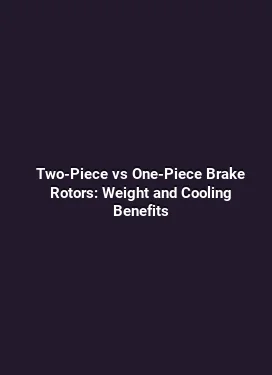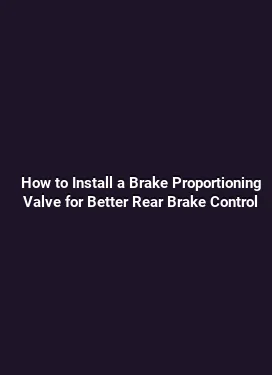How to Bleed ABS Brake System Properly After Brake Upgrade
Upgrading brake components often improves stopping power and pedal feel, but it also introduces air into the hydraulic circuit that can compromise performance if not addressed correctly. ABS-equipped vehicles require a careful bleeding procedure to ensure the hydraulic system remains free of air and any air trapped within the anti-lock braking mechanism is properly purged. This guide provides a comprehensive, step-by-step approach to bleeding an ABS brake system after a brake upgrade, with practical tips, safety considerations, and checks to verify that the system operates as intended.
Preparing for ABS Bleed After an Upgrade

Before starting the bleeding procedure, it is essential to create an organized plan that accounts for the specific vehicle layout and the components involved. The ABS module, pump, and valves can complicate bleeding compared to a traditional non-ABS system, so a methodical approach helps prevent air pockets and ensures consistent bleeding results.
Begin by gathering the required tools and materials: fresh brake fluid of the correct specification (typically DOT 3, 4, or 5.1 as recommended by the manufacturer), a clean container to catch old fluid, a clear plastic hose that fits snugly over the bleeder screws, a wrench appropriate for the bleeder fittings, and a diagnostic or scan tool if available to monitor ABS fault codes. In some vehicles, a dedicated bleeding adapter or a vacuum/pressure bleeder can streamline the process and reduce pedal effort during bleeding. Safety considerations include wearing eye protection and gloves, elevating the vehicle on a stable lift or jack stands, and ensuring the parking brake is disengaged during the procedure.
Understand the impact of brake fluid boiling points and cleanliness. Used fluid can be contaminated with moisture, which lowers boiling point and can lead to vapor formation under hard braking. Keep the brake fluid reservoir clean and free of contaminants. If the reservoir cap is opened for an extended period, wipe the cap area and the neck to minimize debris ingress. Finally, confirm the upgrade components are installed correctly, including caliper pistons, brake pads, rotors, and banjo bolt seals, because residual misfits can affect bleed efficiency and pedal feel.
Understanding the ABS Bleed Process
Bleeding an ABS-equipped system differs from a plain hydraulic bleed because air can become trapped behind the ABS module and pump. Some vehicles require a dedicated bleed procedure that activates the ABS pump to purge air through the system. The general goals remain the same: remove air bubbles from the entire hydraulic circuit, ensure fresh fluid reaches all corners of the network, and restore firm pedal feel without a soft, spongy response.
Trace the bleed path from the master cylinder to each wheel. In most setups, air can travel from the master cylinder through the ABS module to the wheel circuits. The order of wheel bleeding follows the vehicle’s service manual, but a common approach is to bleed from the farthest wheel to the nearest (e.g., passenger rear, driver rear, passenger front, driver front). This sequence helps push trapped air toward the master cylinder, where it can be expelled as fluid level is replenished. In systems with diagonal circuits or tandem masters, a more specific bleeding order may apply. Always consult the vehicle’s service documentation when available.
Two primary bleeding methods are used in ABS systems: gravity/bench bleeding and pressure/ vacuum-assisted bleeding. Gravity bleeding is straightforward but slower; it relies on gravity to bring new fluid through the lines. Vacuum and pressure methods can speed up the process and are particularly helpful when dealing with stubborn air pockets around the ABS module. In all cases, the goal is to maintain a steady, controlled flow and avoid introducing new air through a loose connection or contaminated fluid.
Bleed Sequence and ABS Activation

One practical consideration is ABS activation during bleeding. Some vehicles require cycling the ignition or using a scan tool to command the ABS pump through a bleeding routine. This step forces the ABS module to pump fluid through the circuit, dislodging air from the internal passages that standard gravity bleeding might miss. If the vehicle supports it, perform a dedicated ABS bleed with the engine off, then repeat the regular wheel bleed sequence. This helps ensure air is expelled from the most inaccessible sections of the system.
During the bleeding process, observe the fluid color and consistency. Clear, colorless or light amber fluid indicates fresh brake fluid entering the system. If you notice dark, contaminated, or frothy fluid, pause and inspect for contamination, moisture intrusion, or improper component fitment. A thorough flush may be required to fully purge such contaminants from the lines and ABS module.
Tools and Fluids for Safe Bleeding
Choosing the right tools can dramatically affect the ease and reliability of the bleed. Quality bleeder screws, compatible wrenches, and clean fluid handling equipment minimize the risk of reintroducing air or debris. A transparent hose over the bleeder screw allows real-time observation of air bubbles and fluid movement, which helps verify when air has been expelled completely.
Brake fluid selection should align with manufacturer recommendations. The correct specification ensures optimal lubricity, corrosion resistance, and compatibility with new brake components. Store brake fluid in a tightly sealed container to prevent moisture absorption, and only draw the amount needed for the bleeding session to avoid exposing more fluid than necessary to air exposure.
When using a pressure or vacuum system, regulate the pressure carefully to avoid spillage or excessive force that could dislodge seals or cause leaks. For vacuum bleeding, maintain a steady, moderate suction level to pull air without drawing air past the fluid surface or creating back-bleeding into the reservoir. A clean, uncluttered workspace helps maintain organization and reduces the chance of crossing fluids between different circuits.
Bleeding Procedures: Step-by-Step for Disc/Caliper Layout
Each step below corresponds to a typical four-wheel disc setup, but the approach can be adapted for drum brakes or mixed layouts with drum rears. Start with the farthest wheel from the master cylinder and move inward, ensuring a consistent cadence and fluid replenishment at every step.
Step 1: Prepare the system. Remove the reservoir cap and inspect the fluid level. If the level is low, top it off with the appropriate brake fluid to prevent air from re-entering as you bleed. Attach the clear hose to the farthest wheel’s bleeder screw and place the other end in a container to collect old fluid. Confirm all bleeder screws are clean and thread-in smoothly to avoid cross-threading or leaks.
Step 2: Prime the line. Slowly open the bleeder screw to a quarter-turn and allow fluid to flow until a steady stream without bubbles becomes evident. Close the screw securely, then move to the next wheel in the bleed sequence. If you notice persistent bubbles, repeat the opening cycle until the stream remains steady and bubble-free.
Step 3: Activate the ABS system as required. If the vehicle's procedure calls for cycling the ignition, or if you have access to a diagnostic tool, perform the ABS bleed sequence to purge air from the ABS pump and valves. This step often requires a controlled cycling that cannot be achieved by wheel bleeding alone. After this activation, re-check the fluid level and continue with the wheel bleed process to remove any residual air that has been displaced toward the master cylinder during ABS operation.
Step 4: Repeat the wheel bleed. Return to the opposite side and repeat the bleed on each wheel in the chosen sequence. Some technicians perform two full rounds to ensure no air pockets remain, especially after upgrading brake components that alter line length or create additional air-holding volumes inside the calipers or lines.
Step 5: Check pedal feel and fluid status. With the reservoir cap off, have an assistant press the brake pedal slowly while you observe the fluid reservoir level and the line connections. A firm, consistent pedal with minimal pedal travel generally indicates proper air removal. If the pedal remains soft or sinks after multiple cycles, re-check all connections for leaks and confirm that the ABS system has completed any required activation steps.
Post-Bleed Verification and Bedding-In New Pads
After completing the bleed, a careful verification process ensures the system is ready for road use. Begin with a slow, controlled brake test at low speed in a safe environment. Gradually increase brake pressure to simulate normal driving conditions while monitoring for a firm pedal and predictable braking response. If the pedal becomes spongy or the brake feel changes under load, recheck the fluid level, bleed process, and component integrity.
Bead the new pads and rotor surfaces by performing a series of controlled stops from moderate speeds (e.g., 30–40 mph) to build heat and establish consistent pad transfer. Follow the manufacturer’s bedding-in recommendations to maximize friction performance and rotor life. Note that ABS-equipped systems may require slightly different bedding procedures to account for electronic control during break-in. If the vehicle exhibits any ABS light illumination after the procedure, consult a diagnostic tool to scan for fault codes and address any sensor or pump issues promptly.
In addition to mechanical checks, consider a short test drive that includes varying road surfaces and traffic conditions. This helps ensure the brake system maintains stable pedal feel in real-world scenarios. Regularly inspect fluid levels and check for any signs of leaks in the line connections or around the calipers, which could indicate improper bleeding or installation issues that need to be addressed to prevent future air ingress.
Long-term maintenance includes revisiting the brake fluid at intervals recommended by the vehicle manufacturer. Brake fluid is hygroscopic and absorbs moisture over time, which can reduce braking efficiency and increase the risk of vapor formation under heavy braking. A routine flush every couple of years or as specified helps sustain consistent braking performance and system longevity.
Understanding the interplay of trend terms and semantically related concepts, such as fluid dynamics, air entrapment, pedal feel, and ABS calibration, enhances the practical value of the bleeding process. Recognizing how these elements influence each other allows for more precise troubleshooting and better outcomes after a brake upgrade. The approach outlined above balances methodical discipline with practical, real-world steps that car enthusiasts and professional technicians can apply with confidence.






